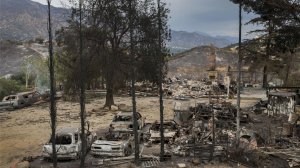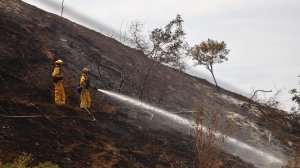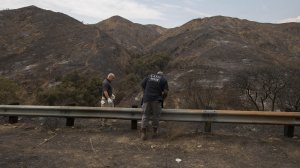As firefighting efforts continued for a fourth day Monday, crews were working slowly to increase the fire line around the 7,000-acre La Tuna Fire, with officials saying they anticipated one of the largest wildfires in Los Angeles history to be fully contained by the end of the week.

Containment for the massive blaze burning in the Verdugo Mountains remained at 30 percent Monday afternoon — the same as Sunday night.
On Monday morning, Los Angeles Fire Department Fire Chief Ralph Terrazas had said he expected a “higher number” by the afternoon, but fire officials said at a 4 p.m. news conference that firefighters were encountering steep and treacherous mountain terrain that made it challenging to get a line around the burned area.
Despite favorable weather and rain on Sunday, containment and acreage remained the same Monday, and the next update is expected at 10 a.m. Tuesday. Firefighters are working to ensure that hot spots are completely extinguished.
“There’s really no active fire left. That can change, though, with the wind,” Terrazas said.
On Tuesday, firefighters expect to begin bringing containment lines “full circle,” county fire Assistant Chief Tom Ewald said Monday afternoon.
“We need to be very diligent to ensure that all the hot spots – all the internal heat, the large logs and large pieces of material that are smoldering – are completely extinguished to ensure that if we receive elevated temperatures later in the week, if we receive any wind, that we don’t have any chance of this fire … spreading,” Ewald said.
“Today was a good day, weather-wise. … We were able to make tremendous progress and what I would consider gaining the upper hand on this fire,” Ewald concluded.
https://twitter.com/LAFD/status/904787102872723456
All mandatory and voluntary evacuations have been lifted, and evacuation centers are closed. After a two-day closure, the 210 Freeway reopened Sunday, but some exits remained shut down Monday.
More than 1,060 firefighters were still working the fire Monday.
Since erupting Friday afternoon, the blaze has scorched 7,003 acres, destroyed four homes and three outbuildings. State Sen. Anthony Portantino noted the La Tuna Fire area is “rimmed by houses.”
Eight people have been injured during the fire, according to city fire Deputy Chief Trevor Richmond: four firefighters and a civilian with heat-related injuries; one firefighter with mild burns; one firefighter with an allergic reaction; and another civilian with a minor eye injury.

Terrazas noted that fatigue was setting in for many firefighters, although he added that most had a good rest period Sunday night.
The fire chief also issued a warning about drones following a “drone incursion” in the burn area.
“I want to remind the public: if a drone is in the air, we cannot launch our helicopters or the fixed-wing,” he said. “In this scenario, they can be very detrimental to us today.”
The person was operating the drone for about 15 minutes before he was spotted by other people, who reported him, according to the chief. The individual fled, and local law enforcement is dealing with the incident.
The fast-moving La Tuna Fire prompted the evacuation of more than 700 homes in Burbank, Glendale and the Sunland-Tujunga area of Los Angeles, impacting some 1,400 residents, according to L.A. Mayor Eric Garcetti.

On Sunday, Gov. Brown declared a state of emergency for L.A. County, paving the way for more personnel and equipment to be used in fighting the fire at the direction of the California Office of Emergency Services.
Brown’s declaration came one day after Garcetti signed a local emergency, instructing all city agencies to “take all necessary steps to protect life and property in the area.”
In a tweet, the mayor noted the fire was the single-largest by acreage in the city’s history.
The fire broke out along the north side of La Tuna Canyon Road around 1:30 p.m. Friday, the hottest day of a scorching heat wave that began earlier in the week.

Firefighters initially stopped forward progress within 30 minutes, but winds began to pick up, sending embers across the freeway and causing it to spread on both sides of the interstate, according to LAFD spokeswoman Margaret Stewart.
Within hours, the blaze sent up tall columns of thick, black smoke that were visible for miles, raining down ash in surrounding cities as the blaze spread rapidly.
Three days later, health officials continued to warn of “unhealthy” and “overall poor” air quality in the county, particularly in the San Fernando Valley, portions of the San Gabriel Valley, the San Gabriel Mountains and the Glendale area.
While winds helped fuel the fire’s spread, crews were hampered in the firefight by wild weather over the weekend, including triple-digit heat and sudden downpours. But conditions in the early part of the week were expected to be cooler and drier. On Sunday, Terrazas said the fire could be 100 contained within three to four days.
“We are optimistic about making big progress today and the rest of the week,” he said.
It was still not known what sparked the destructive fire, and arson investigators are working to determine its cause.
https://twitter.com/LAFD/status/904727335085027328





